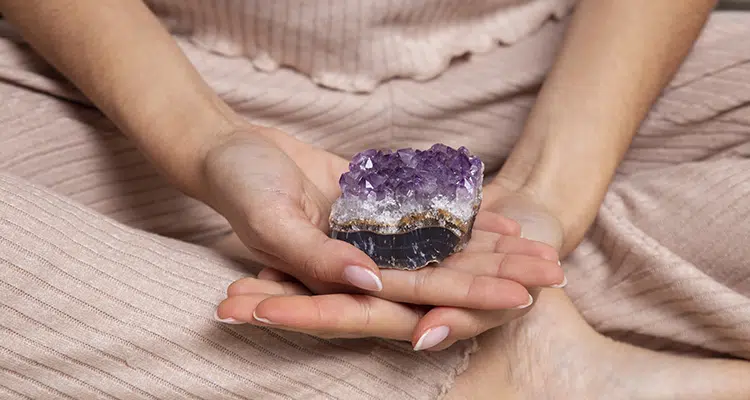Trouble Staying Asleep? How to Treat Middle of the Night Insomnia
Most people wake up, on average, three to four times per night. While this may seem excessive, it’s considered part of a healthy sleep pattern. Triggers for waking up in the middle of the night vary greatly from one person to the next. Some people wake up to use the bathroom or because they’re thirsty, while others have nightmares or are woken by external noise or light. When you know your triggers, you can work to prevent and eliminate them.
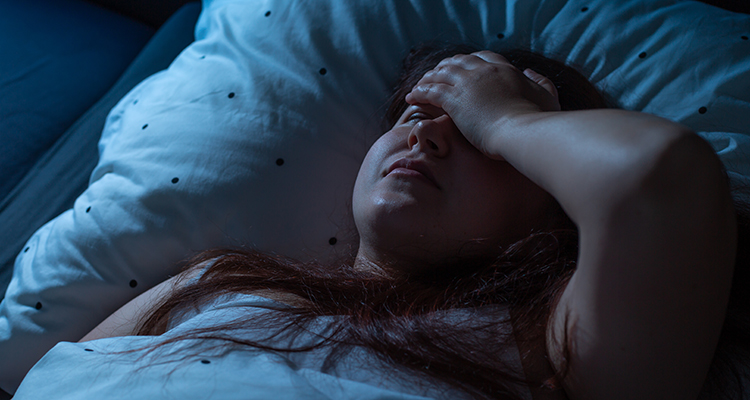
If you find yourself waking up more than a few times per night or have trouble falling back asleep after waking up, you may be suffering from middle-of-the-night insomnia. Other symptoms include having trouble falling asleep initially and then waking at the same time every night. For example, waking at midnight and then lying awake staring at the ceiling as you struggle to fall back to sleep.
These constant disruptions in your sleep patterns and cycle can cause a myriad of problems both physically and mentally. Keep reading to learn more about middle-of-the-night insomnia including causes, symptoms, and insomnia therapy options.
Content
Understanding Healthy Sleep Patterns
Sleeping straight through the night without disruption is pretty uncommon. Even if you don’t realize it, most people experience mini-awakenings at least 20 times per night. This includes tossing and turning, adjusting your pillow, and even dreaming. While these are all normal, healthy parts of your body’s natural sleep pattern, waking numerous times and staying awake for longer than a few moments is not only unhealthy but a sign of a bigger problem.
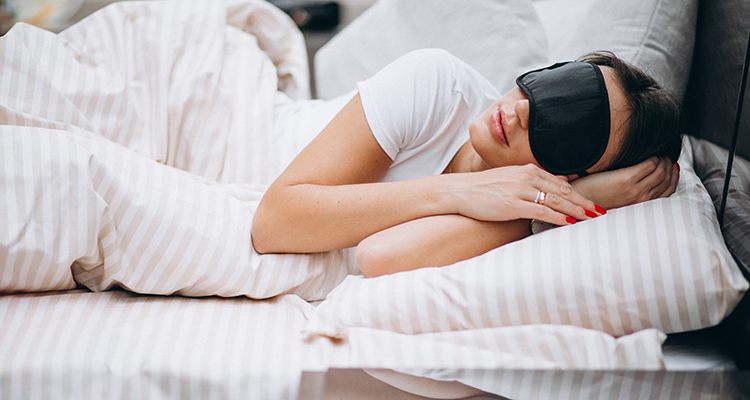
Before we cover exactly what causes middle-of-the-night insomnia and what you can do to help, it’s important to understand how your natural sleep patterns work. History tells us that most people sleep in two distinct bouts with a period of wakefulness in between. Before the invention of electricity, people gauged their wake and sleep cycle on the rising and setting of the sun. This meant most adults would be blanketed in darkness for up to 15 hours per night. With the introduction of artificial light and digital devices, many people have shortened their sleep time and significantly increased their waking hours.
It’s recommended that adults get between 7 and 9 hours of sleep each night. Doing so supports a healthy immune system, brain function, and both physical and mental well-being. According to the National Sleep Foundation, you experience four sleep stages approximately 4 to 6 times per night. This is known as your sleep cycle. The stages are:
- Stage 1 (transition period between awake and sleeping – lasts 5 to 10 minutes)
- Stage 2 (body temperature lowers and heart rate slows – lasts 20 minutes)
- Stage 3 (muscles relax and your deepest sleep occurs – lasts approximately 30 minutes)
- Stage 4 (REM sleep when dreams occur and your eyes move rapidly – lasts 10 minutes)
From start to finish, your sleep cycle lasts approximately 90 minutes. On a good night, you’ll experience 4 to 6 sleep cycles, achieving deep, restorative sleep.
Those suffering from middle-of-the-night insomnia struggle to successfully complete sleep cycles as their sleep is constantly interrupted. These interruptions come in various forms. While some are out of your control, others can be addressed and rectified to help you combat insomnia and achieve restful, quality sleep.
What Causes Middle-of-the-Night Insomnia?
The best defense against middle-of-the-night insomnia is a strong offense. That means knowing and recognizing what’s waking you up or disrupting your sleep. Here are some of the most common reasons people wake up during the night.
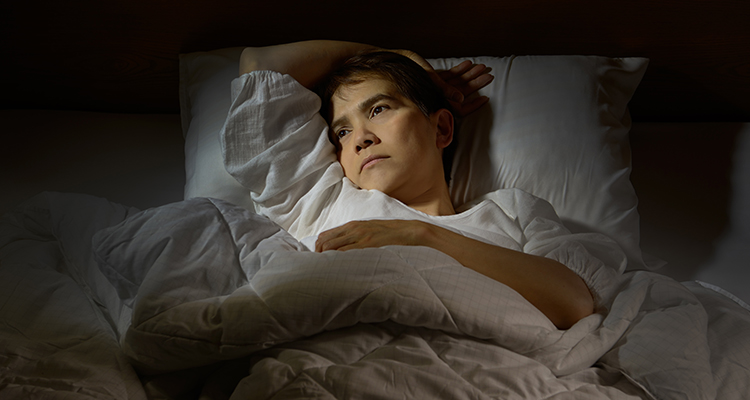
Environmental Changes
One of the main triggers for disturbed sleep is changes and triggers in your environment. These include changes in temperature, light, noise, or comfort.
The optimum sleeping temperature is approximately 65 degrees Fahrenheit. Set your house’s thermostat between 65 and 70 degrees to maintain a comfortable atmosphere. When the room is too hot, your body temperature will rise, causing sweating, discomfort, and wakefulness. On the flip side, if your room is too cold, you may wake up in search of extra blankets or warmth.
External light and noise can also wake you up. Invest in room darkening shades or a sleep mask to eliminate outside light from creeping in. Turn off your television, phone, and other screens. Not only is the light disruptive but it can prevent the release of much-needed melatonin. Most outside noises are out of your control. Car alarms, loud neighbors, and inclement weather can all wake you from a restful sleep. To prevent this, try running a fan or using a sound machine.
The right temperature isn’t the only thing that keeps you comfortable during the night. Choose a pillow and mattress that offer adequate support. Your sleeping position matters too. Side sleeping helps reduce acid reflux, relieve back pain, and prevent snoring. Sleeping on your back can help reduce neck pain and improve nasal congestion. Approximately 7% of people sleep on their stomach, which may also reduce neck and back pain by relieving pressure on the spine.
Nightmares
Nightmares affect more than just children. In fact, as many as 85% of adults report having occasional nightmares. These upsetting and vivid dreams are common during REM sleep when your brain is most active. Stress, anxiety, and racing thoughts are common triggers for nightmares. By reducing your stress and handling whatever thoughts and emotions are troubling you, you may be able to lessen the frequency of unpleasant dreams that are waking you in the middle of the night. Certain foods and sleep disorders can also trigger nightmares in adults. Cognitive-behavioral therapy (CBT) techniques may also help reduce nightmares and negative thoughts.
Bathroom Use
Two-thirds of adults over the age of 70 wake at least once during the night to urinate. Another 60% of older adults report waking between 2 and 3 times per night to use the bathroom. While waking periodically to use the bathroom is common and increases with age, waking several times a night for an extended period of time could be a sign of a bigger problem like a kidney or bladder infection. Other symptoms of a urination problem include lower back pain near your kidneys, discolored or bloody urine, pain when urinating, and strong-smelling urine. Limiting fluids before bed is another way to prevent frequent urination during the night if no medical issue is present.
Unhealthy Habits Before Bed
Certain things like alcohol, caffeinated beverages, and large meals before bed can all disrupt your sleep. While some people use alcohol to relax at night, it can actually cause you to wake soon after falling asleep. Caffeine is a natural stimulant, making it difficult to fall asleep and achieve deep sleep. Things like tea, coffee, and energy drinks too close to bedtime can trigger middle-of-the-night insomnia. While a small snack before bed is harmless, eating too big a meal before laying down can cause both discomfort and gastrointestinal issues. You may also find yourself feeling more alert as your body works to digest the food you just ate.
How to Prevent Middle-of-the-Night Insomnia: Dos and Don’ts
If you’re tired of tossing and turning or staring at the ceiling for hours in the middle of the night, it’s time for a change. Certain behaviors can not only trigger your insomnia but may also aggravate it.
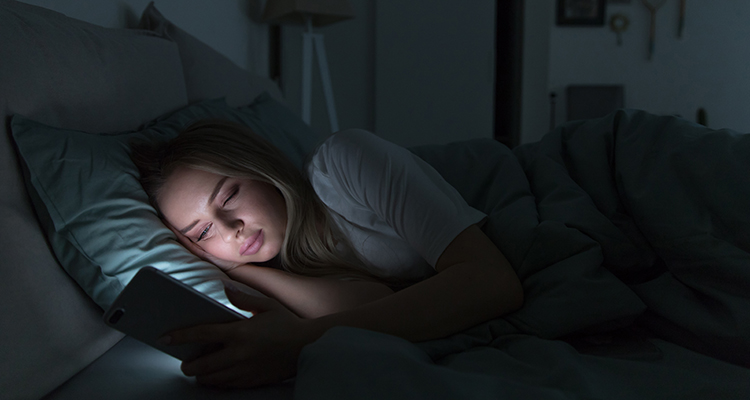
Here are the dos and don’ts of treating middle-of-the-night insomnia once and for all.
What NOT to Do
Chances are, you may be triggering your middle-of-the-night insomnia without even realizing it. Here are a few behaviors to avoid as you try to combat your sleep troubles and finally achieve long-lasting, restful sleep.
Don’t Watch the Clock
We’re all guilty of this. As the seconds and minutes tick by and sleep evades you, your eyes wander to the clock displayed on your bedside or dresser. Watching the time go by is one of the worst things you can do when facing middle-of-the-night insomnia. Place your phone face down on the nightstand or keep it across the room. Turn your alarm clock to face the wall. Resist all temptation to check the time. Doing so will only increase your stress and anxiety over not sleeping.
Don’t Lay in Bed Awake
It takes the average person about 10 minutes to fall asleep. While this is fine, lying in bed awake for longer than 20 minutes will only cause increased anxiety and make it more difficult to drift off. Staying in bed while awake interferes with your body’s circadian rhythm or natural sleep-wake cycle. Instead of willing yourself to sleep (which never works, by the way), get up and engage in a relaxing behavior without turning on the lights or using a digital device. Enjoying a hot cup of tea or meditating are two effective methods. Once you feel tired enough for sleep, return to bed.
This helps strengthen the connection between your bed and sleep. Another way to achieve this is by reserving your bed for sleep and sex only. Avoid eating, working, or watching television in bed.
Don’t Neglect Health Issues
Chronic pain and underlying health issues are two of the most common causes of insomnia. Don’t neglect signs that your health is at risk. Pain, swelling, and discomfort may be what’s keeping you up at night. Chronic pain is often worse at night or when you lay down. In addition to pain, sleep apnea, nasal congestion, and obesity can also cause insomnia. Treating your underlying health issues may just be the answer to your sleep troubles.
Do Create a Sleep Schedule (and Stick to It)
The human body thrives on routine. Going to bed and waking at the same time each day and night helps train your body and brain to fall asleep and wake up feeling alert and rejuvenated. Life can get hectic, but whenever possible, go to sleep at the same time during the week and on weekends. Set an alarm so you can wake up around the same time every morning. Daytime naps can also interfere with your sleep schedule so avoid falling asleep during off-hours.
Do Relax and Destress
This is often easier said than done but getting into a relaxing mind frame before bed is key for combating middle-of-the-night insomnia. Relaxation is both physical and mental. Start with the physical by practicing progressive muscle relaxation. This involves moving through every muscle group starting at your head, down your neck and shoulders to your torso, and ending at your feet. Take note of what muscles feel tense or tight and work on clenching and releasing them. Performing a “body check” is a popular technique in yoga and meditation as well. Accompany this with controlled breathing. This technique works to relax both your mind and body.
Other ways to destress before bed include reading a book (avoid an e-book or Kindle), listening to soothing music, taking a warm bath, or journaling. All of these activities help to quiet your mind and release negative thoughts, better preparing you for sleep and preventing intruding thoughts from waking you.
Take a Multi-Faceted Approach to the Healing Process
Any number of things can cause middle-of-the-night insomnia, which is why a multi-faceted approach works best. You won’t be able to eliminate all sleep disturbances overnight, but with the right approach, you can improve your chances of falling and staying asleep.

First, identify the cause of your middle-of-the-night insomnia. If you’re unsure, keep track of when you wake up, why, and how long you’re awake. Doing this can help you identify a pattern in your sleep disturbances. Next, make minor adjustments to your sleep schedule, environment, and health that may reduce how often you wake up. When you do wake up, avoid engaging in stimulating behaviors. Instead, stick with relaxing routines that can be done in dim lighting. Once you feel tired enough for sleep, return to bed.
In addition to these techniques, CBT for insomnia can combat any negative thoughts and feelings associated with your condition. At Somnus Therapy, we use this approach as well as other techniques to help you identify, understand, and overcome whatever type of insomnia you’re facing.







